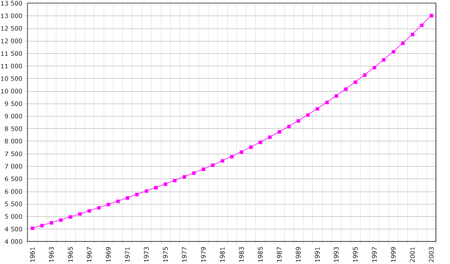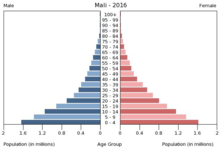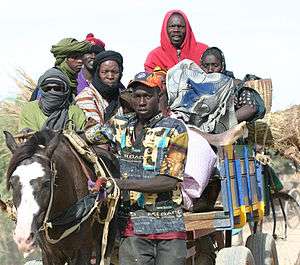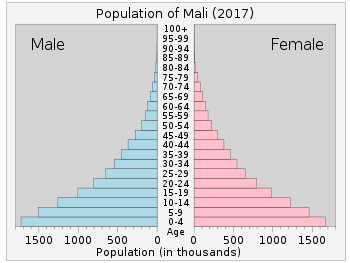Demographics of Mali
This article is about the demographic features of the population of Mali, including population density, ethnicity, education level, health of the populace, economic status, religious affiliations and other aspects of the population.

Population
In 2018, Mali's population was an estimated 19.1 million[1][2], with an annual growth rate of 2.7%.[3] This figure can be compared to 4,638,000 in 1950.[4] The population is predominantly rural (68% in 2002), and 5–10% of Malians are nomadic.[5] More than 90% of the population lives in the southern part of the country, especially in Bamako, which has over 1 million residents.[5]
In 2007, about 48% of Malians were less than 15 years old, 49% were 15–64 years old, and 3% were 65 and older.[3] The median age was 15.9 years.[3] The birth rate in 2007 was 49.6 births per 1,000, and the total fertility rate was 7.4 children per woman.[3]
The death rate in 2007 was 16.5 deaths per 1,000.[3] Life expectancy at birth was 49.5 years total (47.6 for males and 51.5 for females).[3] Mali has one of the world's highest rates of infant mortality,[5] with 106 deaths per 1,000 live births.[3]
The proportion of the population aged below 15 in 2010 was 47.2%.[4] 50.6% of the population were aged between 15 and 65 years of age. 2.2% of the population were aged 65 years or older.[4]
| Total population | Population aged 0–14 (%) | Population aged 15–64 (%) | Population aged 65+ (%) | |
|---|---|---|---|---|
| 1950 | 4 638 000 | 38.9 | 58.3 | 2.8 |
| 1955 | 4 928 000 | 40.1 | 57.4 | 2.5 |
| 1960 | 5 248 000 | 40.5 | 57.2 | 2.3 |
| 1965 | 5 597 000 | 41.5 | 56.2 | 2.3 |
| 1970 | 6 034 000 | 42.3 | 55.2 | 2.4 |
| 1975 | 6 604 000 | 43.3 | 54.1 | 2.6 |
| 1980 | 7 246 000 | 44.6 | 52.6 | 2.8 |
| 1985 | 8 010 000 | 45.8 | 51.3 | 2.9 |
| 1990 | 8 673 000 | 47.5 | 49.5 | 3.0 |
| 1995 | 9 825 000 | 47.4 | 49.9 | 2.8 |
| 2000 | 11 295 000 | 47.2 | 50.3 | 2.5 |
| 2005 | 13 177 000 | 47.1 | 50.6 | 2.3 |
| 2010 | 15 370 000 | 47.2 | 50.6 | 2.2 |
Structure of the population

Structure of the population (01.04.2009) (Census, Complete tabulation):[6]
| Age Group | Male | Female | Total | % |
|---|---|---|---|---|
| Total | 7 204 990 | 7 323 672 | 14 528 662 | 100 |
| 0-4 | 1 328 871 | 1 294 514 | 2 623 385 | 18,06 |
| 5-9 | 1 202 875 | 1 154 948 | 2 357 823 | 16,23 |
| 10-14 | 918 866 | 865 138 | 1 784 004 | 12,28 |
| 15-19 | 732 526 | 783 620 | 1 516 146 | 10,44 |
| 20-24 | 529 535 | 612 368 | 1 141 903 | 7,86 |
| 25-29 | 449 099 | 546 603 | 995 702 | 6,85 |
| 30-34 | 385 003 | 427 795 | 812 798 | 5,59 |
| 35-39 | 325 005 | 326 894 | 651 949 | 4,49 |
| 40-44 | 271 239 | 275 364 | 546 603 | 3,76 |
| 45-49 | 228 626 | 217 261 | 445 887 | 3,07 |
| 50-54 | 189 424 | 192 382 | 381 806 | 2,63 |
| 55-59 | 148 594 | 134 083 | 282 677 | 1,95 |
| 60-64 | 127 557 | 123 461 | 251 018 | 1,73 |
| 65-69 | 88 292 | 77 082 | 165 374 | 1,14 |
| 70-74 | 67 319 | 66 063 | 133 382 | 0,92 |
| 75-79 | 40 904 | 36 197 | 77 101 | 0,53 |
| 80+ | 41 992 | 43 602 | 85 594 | 0,59 |
| unknown | 129 213 | 146 297 | 275 510 | 1,90 |
| Age group | Male | Female | Total | Percent |
|---|---|---|---|---|
| 0-14 | 3 450 612 | 3 314 600 | 6 765 212 | 46,56 |
| 15-64 | 3 386 658 | 3 639 831 | 7 026 489 | 48,36 |
| 65+ | 238 507 | 222 944 | 461 451 | 3,18 |
Structure of the population (DHS 2012-2013) (Males 27 571, Females 28 264 = 55 836) :
| Age Group | Male (%) | Female (%) | Total (%) |
|---|---|---|---|
| 0-4 | 19,7 | 18,3 | 19,0 |
| 5-9 | 18,8 | 17,7 | 18,3 |
| 10-14 | 15,9 | 14,8 | 15,3 |
| 15-19 | 7,4 | 7,1 | 7,2 |
| 20-24 | 4,5 | 6,9 | 5,7 |
| 25-29 | 4,5 | 7,7 | 6,1 |
| 30-34 | 4,7 | 6,1 | 5,4 |
| 35-39 | 4,6 | 4,9 | 4,8 |
| 40-44 | 3,8 | 3,3 | 3,5 |
| 45-49 | 3,4 | 2,4 | 2,9 |
| 50-54 | 2,9 | 4,9 | 3,9 |
| 55-59 | 2,1 | 2,2 | 2,1 |
| 60-64 | 2,9 | 1,8 | 2,3 |
| 65-69 | 2,0 | 0,9 | 1,5 |
| 70-74 | 1,2 | 0,5 | 0,9 |
| 75-79 | 0,7 | 0,3 | 0,5 |
| 80+ | 0,8 | 0,3 | 0,5 |
| unknown | 0,1 | 0,1 | 0,1 |
| Age group | Male (%) | Female (%) | Total (%) |
|---|---|---|---|
| 0-14 | 54,4 | 50,8 | 52,6 |
| 15-64 | 40,8 | 47,1 | 43,9 |
| 65+ | 4,7 | 2,0 | 3,4 |
Ethnic groups

Ethnic groups include:[7] Bambara 33.3%, Fulani (French: Peul; Fula: Fulɓe) 13.3%, Sarakole 9.8%, Senufo 9.6%, Malinke 8.8%, Dogon 8.7%, Songhai 5.9%, Bobo 2.1%, Tuareg/Bella 1.7%, other Malian 6%, ECOWAS citizens 0.4%, other 0.3% (2018 est.).
Mali's population consists of Sub-Saharan ethnic groups, sharing similar historic, cultural, and religious traditions. Exceptions are two nomadic northern groups, the Tuaregs, a Berber people, and Maurs (or Moors), of Arabo-Berber origins. In Mali and Niger, the Moors are also known as Azawagh Arabs, named after the Azawagh region of the Sahara.[8] Azawagh Arabs speak mainly Hassaniya Arabic which is one of the regional varieties of Arabic.[9]
The Tuaregs traditionally have opposed the central government. Starting in June 1990 in the north, Tuaregs seeking greater autonomy led to clashes with the military. In April 1992, the government and most opposing factions signed a pact to end the fighting and restore stability in the north. Its major aims are to allow greater autonomy to the north and increase government resource allocation to what has been a traditionally impoverished region. The peace agreement was celebrated in 1996 in Timbuktu during an official and highly publicized ceremony called "Flamme de la Paix"--(peace flame).
Historically, interethnic relations throughout the rest of the country were facilitated by easy mobility on the Niger River and across the country's vast savannahs. Each ethnic group was traditionally tied to a specific occupation, all working within proximity to each other, although the distinctions were often blurred.
The Bambara, Malinké, Sarakole, Dogon and Songhay are farmers; the Fula or Fulani, Maur, and Tuareg are herders, while the Bozo are fishers. In recent years this linkage has shifted considerably, as ethnic groups seek nontraditional sources of income.
White people in Mali
Mixed European/African descendants of Muslims of Spanish, as well some French, Irish, Italian and Portuguese origins live in Mali, they are known as the Arma people (1% of the nation's population). White Malians live in Bamako, Sikasso, Kalabancoro, Koutiala, Ségou, Kayes, Kati, Mopti, Niono, Gao, San, Koro, Bla, Bougouni, Mandé, Baguineda-Camp, Kolondiéba, Kolokani, and others.[10]
Vital statistics
Registration of vital events is in Mali not complete. The Population Departement of the United Nations prepared the following estimates. [4]
| Period | Live births per year | Deaths per year | Natural change per year | CBR* | CDR* | NC* | TFR* | IMR* |
|---|---|---|---|---|---|---|---|---|
| 1950-1955 | 231 000 | 166 000 | 65 000 | 48.4 | 34.7 | 13.6 | 6.48 | 175 |
| 1955-1960 | 248 000 | 175 000 | 74 000 | 48.8 | 34.3 | 14.5 | 6.65 | 173 |
| 1960-1965 | 266 000 | 182 000 | 84 000 | 49.1 | 33.7 | 15.5 | 6.75 | 168 |
| 1965-1970 | 287 000 | 180 000 | 107 000 | 49.4 | 31.0 | 18.4 | 6.87 | 162 |
| 1970-1975 | 312 000 | 179 000 | 133 000 | 49.3 | 28.3 | 21.1 | 6.93 | 156 |
| 1975-1980 | 343 000 | 179 000 | 163 000 | 49.5 | 25.9 | 23.6 | 7.01 | 149 |
| 1980-1985 | 377 000 | 181 000 | 196 000 | 49.4 | 23.7 | 25.8 | 7.07 | 141 |
| 1985-1990 | 408 000 | 179 000 | 229 000 | 48.9 | 21.5 | 27.4 | 7.09 | 135 |
| 1990-1995 | 450 000 | 185 000 | 265 000 | 48.7 | 20.1 | 28.7 | 7.01 | 127 |
| 1995-2000 | 519 000 | 196 000 | 323 000 | 49.1 | 18.6 | 30.5 | 6.88 | 119 |
| 2000-2005 | 600 000 | 210 000 | 390 000 | 49.0 | 17.2 | 31.8 | 6.71 | 111 |
| 2005-2010 | 680 000 | 221 000 | 459 000 | 47.6 | 15.5 | 32.1 | 6.46 | 101 |
| * CBR = crude birth rate (per 1000); CDR = crude death rate (per 1000); NC = natural change (per 1000); IMR = infant mortality rate per 1000 births; TFR = total fertility rate (number of children per woman) | ||||||||
Births and deaths[6]
| Year | Population | Live births | Deaths | Natural increase | Crude birth rate | Crude death rate | Rate of natural increase | TFR |
|---|---|---|---|---|---|---|---|---|
| 2009 | 14 517 176 | 666 216 | 62 371 | 603 845 | 45,9 | 4,3 | 41,6 | |
Fertility and Births
Total Fertility Rate (TFR) (Wanted Fertility Rate) and Crude Birth Rate (CBR):[11]
| Year | CBR (Total) | TFR (Total) | CBR (Urban) | TFR (Urban) | CBR (Rural) | TFR (Rural) |
|---|---|---|---|---|---|---|
| 1981-1983 | 7.10 | 6.85 | 7.17 | |||
| 1984-1986 | 6.73 | 6.09 | 6.97 | |||
| 1995-1996 | 45.1 | 6.7 (6.0) | 39.9 | 5.4 (4.8) | 47.2 | 7.3 (6.6) |
| 2001 | 45.1 | 6.8 (6.1) | 42.1 | 5.5 (4.8) | 45.9 | 7.3 (6.6) |
| 2006 | 45.2 | 6.6 (6.0) | 41.8 | 5.4 (5.1) | 46.6 | 7.2 (6.5) |
| 2012-2013 | 38.8 | 6.1 (5.3) | 36.7 | 5.0 (4.3) | 39.2 | 6.5 (5.6) |
| 2018 | 40.9 | 6.3 (5.5) | 36.3 | 4.9 (4.2) | 42.3 | 6.8 (6.0) |
Fertility data as of 2012-2013 (DHS Program):[12]
| Region | Total fertility rate | Percentage of women age 15-49 currently pregnant | Mean number of children ever born to women age 40-49 |
|---|---|---|---|
| Kayes | 6.0 | 11.3 | 6.0 |
| Koulikoro | 6.0 | 14.3 | 5.8 |
| Sikasso | 6.6 | 11.5 | 6.2 |
| Ségou | 6.1 | 12.2 | 6.1 |
| Mopti | 6.5 | 11.7 | 5.9 |
| Bamako | 5.1 | 6.5 | 5.1 |
Immigration and emigration
Mali had an estimated net migration rate of –6.6 migrants per 1,000 people in 2006.[13] About 3 million Malians are believed to reside in Côte d'Ivoire and France. Conversely, according to a 2003 estimate, Mali hosts about 11,000 Mauritanians; most are Fulani herders who routinely engage in cross-border migration. In addition, there are several thousand refugees from Côte d'Ivoire, Sierra Leone, and Liberia in Bamako and other urban areas of Mali.[5]
Demographic statistics
Demographic statistics according to the World Population Review in 2019.[14]
- One birth every 39 seconds
- One death every 3 minutes
- One net migrant every 13 minutes
- Net gain of one person every 55 seconds
The following demographic are from the CIA World Factbook[15] unless otherwise indicated.
Population
- 18,429,893 (July 2018 est.)
Age structure

- 0-14 years: 48.03% (male 4,449,790 /female 4,402,076)
- 15-24 years: 18.89% (male 1,657,609 /female 1,823,453)
- 25-54 years: 26.36% (male 2,243,158 /female 2,615,695)
- 55-64 years: 3.7% (male 346,003 /female 335,733)
- 65 years and over: 3.02% (male 277,834 /female 278,542) (2018 est.)
Median age
- total: 15.8 years. Country comparison to the world: 227th
- male: 15.2 years
- female: 16.5 years (2018 est.)
Birth rate
- 43.2 births/1,000 population (2018 est.) Country comparison to the world: 3rd
Death rate
- 9.6 deaths/1,000 population (2018 est.) Country comparison to the world: 45th
Total fertility rate
- 5.9 children born/woman (2018 est.) Country comparison to the world: 5th
Population growth rate
- 2.98% (2018 est.) Country comparison to the world: 8th
Mother's mean age at first birth
- 18.8 years (2012/13 est.)
- note: median age at first birth among women 25-29
Contraceptive prevalence rate
- 15.6% (2015)
Net migration rate
- -3.9 migrant(s)/1,000 population (2017 est.) Country comparison to the world: 181st
Religions
Muslim 94.8%, Christian 2.4%, Animist 2%, none 0.5%, unspecified 0.3% (2009 est.)
Dependency ratios
- total dependency ratio: 101.9 (2015 est.)
- youth dependency ratio: 96.8 (2015 est.)
- elderly dependency ratio: 5.1 (2015 est.)
- potential support ratio: 19.5 (2015 est.)
Urbanization
- urban population: 42.4% of total population (2018)
- rate of urbanization: 4.86% annual rate of change (2015-20 est.)
Life expectancy at birth
- total population: 60.8 years (2018 est.)
- male: 58.6 years (2018 est.)
- female: 63 years (2018 est.)
Literacy
definition: age 15 and over can read and write (2015 est.)
- total population: 33.1% (2015 est.)
- male: 45.1% (2015 est.)
- female: 22.2% (2015 est.)
School life expectancy (primary to tertiary education)
- total: 7 years (2015)
- male: 8 years (2015)
- female: 7 years (2015)
Unemployment, youth ages 15-24
- total: 30.5% (2016 est.)
- male: 29.6% (2016 est.)
- female: 31.3% (2016 est.)
Languages
Although each ethnic group speaks a separate language, nearly 80% of Malians communicate over ethnic borders in Bambara, which is the common language of the marketplace. French is the country's official language and is spoken somewhat by 30% of Malians.
Religion
An estimated 95% of Malians are Muslim (mostly Sunni), 4% adhere to indigenous or traditional animist beliefs, and 1% are Christian (about two-thirds Roman Catholic and one-third Protestant).[3][5] Atheism and agnosticism are believed to be rare among Malians, most of whom practice their religion on a daily basis.[5] Islam as practiced in Mali can be moderate, tolerant, and adapted to local conditions; relations between Muslims and practitioners of minority religious faiths are generally amicable.[5] The constitution establishes a secular state and provides for freedom of religion, and the government largely respects this right.[5]
Health
Mali's health and development indicators rank among the worst in the world. In 2000 only 62–65 percent of the population was estimated to have access to safe drinking water and only 69 percent to sanitation services of some kind; only 8 percent was estimated to have access to modern sanitation facilities. Only 20 percent of the nation’s villages and livestock watering holes had modern water facilities.[5]
There were an estimated 140,000 cases of human immunodeficiency virus/acquired immune deficiency syndrome (HIV/AIDS) reported in 2003, and an estimated 1.9 percent of the adult population was afflicted with HIV/AIDS that year, among the lowest rates in Sub-Saharan Africa (see also HIV/AIDS in Africa).[5] In the same year, there were 12,000 AIDS deaths. The infant mortality rate is 69.5 deaths/1,000 live births (75.3/1,000 among males and 63.5/1,000 among females) (2017 est.). Life expectancy at birth is 60.3 years (58.2 years among males and 62.5 years among females) (2017 est.).
Life expectancy
| Period | Life expectancy in Years[16] |
|---|---|
| 1950–1955 | 26.96 |
| 1955–1960 | |
| 1960–1965 | |
| 1965–1970 | |
| 1970–1975 | |
| 1975–1980 | |
| 1980–1985 | |
| 1985–1990 | |
| 1990–1995 | |
| 1995–2000 | |
| 2000–2005 | |
| 2005–2010 | |
| 2010–2015 |
Education
In the 2000–01 school year, the primary school enrollment rate was 61% (71% of males and 51% of females). The primary school completion rate is also low: only 36 percent of students in 2003 (and lower for females). The majority of students reportedly leave school by age 12. In the late 1990s, the secondary school enrollment rate was 15% percent (20% of males and 10% of females).[5]
According to United States government estimates, the adult literacy rate (defined as those over age 15 who can read and write) was 46.4 percent for the total population in 2003 (53.5 percent for males and 39.6 percent for females). According to United Nations sources, however, the literacy rate is actually much lower—only 27–30 percent overall and as low as 12 percent for females, among the lowest rates in Africa.
References
- ""World Population prospects – Population division"". population.un.org. United Nations Department of Economic and Social Affairs, Population Division. Retrieved November 9, 2019.
- ""Overall total population" – World Population Prospects: The 2019 Revision" (xslx). population.un.org (custom data acquired via website). United Nations Department of Economic and Social Affairs, Population Division. Retrieved November 9, 2019.
- CIA world factbook.
- Population Division of the Department of Economic and Social Affairs of the United Nations Secretariat, World Population Prospects: The 2010 Revision Archived May 6, 2011, at the Wayback Machine
- Mali country profile. Library of Congress Federal Research Division (January 2005). This article incorporates text from this source, which is in the public domain.
- "United Nations Statistics Division - Demographic and Social Statistics". unstats.un.org. Retrieved 2017-08-27.
- "Africa :: MALI". CIA The World Factbook.
- For an introduction to the culture of the Azawagh Arabs, see Rebecca Popenoe, Feeding Desire — Fatness, Beauty and Sexuality among a Saharan People. Routledge, London (2003) ISBN 0-415-28096-6
- Popenoe (2003), p. 16-17.
- Fage, J. D.; Oliver, Roland Anthony (1975). The Cambridge History of Africa. ISBN 9780521204132.
- "MEASURE DHS: Demographic and Health Surveys". microdata.worldbank.org. Retrieved 2017-08-27.
- "Enquête Démographique et de Santé (EDSM-V) 2012-2013" (PDF). Mali Enquête Démographique et de Santé (EDSM-V).
- CIA factbook
- "Mali Population 2019", World Population Review
- "The World FactBook - Mali", The World Factbook, July 12, 2018

- "World Population Prospects - Population Division - United Nations". esa.un.org. Retrieved 2018-08-26.
Further reading
| Wikimedia Commons has media related to Demographics of Mali. |
- Samaké, Salif; Traoré, Seydou Moussa; Ba, Souleymane; Dembélé, Étienne; Diop, Mamadou; Mariko, Soumaïla; Libité, Paul Roger (2007), Mali: Enquête Démographique et de Santé (EDSM-IV) 2006 (PDF), Calverton, MD, USA: Demographic and Health Surveys.